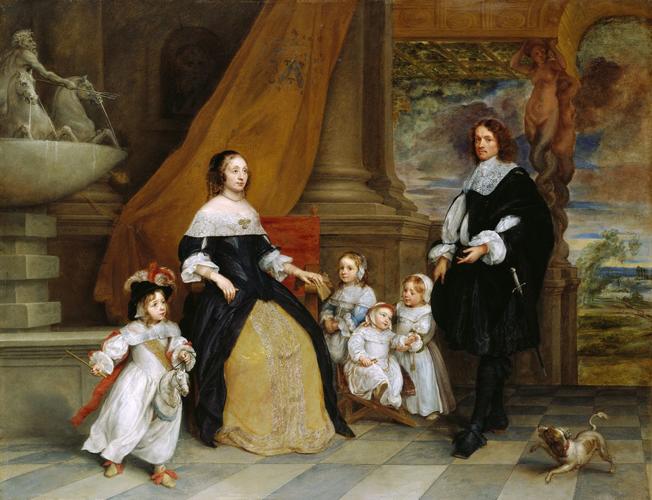-
1 of 253523 objects
The Family of Jan-Baptista Anthoine Signed and dated 1664
Oil on copper | 56.5 x 73.8 cm (support, canvas/panel/stretcher external) | RCIN 405339
-
The career of Gonzales Coques demonstrates the degree to which eighty years of war failed to destroy the cultural links between the northern and southern Netherlands. Born in Antwerp, where he studied with Pieter Brueghel the Younger, by the late 1640s Coques was in Holland, working for the stadtholders Frederick Henry and Amelia van Solms. Thirty years later, in 1671, he became court painter to the Count of Monterrey, the governor of the southern Netherlands.
His style is similarly an integration of the two traditions. The principal influences on his work come from Flanders; his elegant figures appear to be miniature versions of those of Van Dyck, while the (obviously imaginary) architecture derives from Rubens's family portraits and 'conversation pieces' (conversatie), like the Garden of Love (Prado) of 1636. Coques also seeks to emulate the informality with which Rubens depicts his own family, an effect which can also be see in Philip Fruytiers's watercolour of Four Children of Peter Paul Rubens and Helena Fourment with Two maids (Royal Collection) of 1638-9. However, it was Dutch artists who specialised in the depiction on a small scale of boisterous families, with indulgent parents and rowdy children, set in a lucid architectural space. There are excellent examples by Frans Hals, Family Group of c.1635 (Cincinnati Museum), and Pieter de Hooch, Family in a Courtyard in Delft of 1658-60 (Vienna Academy). When he acquired this picture, George IV already owned a Family Group of the same type by the less well-known Dutch artist Barent Graat (1628-1709), dated 1658 (RCIN 405341).
The sitters here can be identified by the coat of arms on the huge curtain: Jan-Baptista Anthoine, knight and postmaster of Antwerp, is shown with his wife Susanna de Lannoy, two sons, Louis and Jan-Baptista, and two daughters, Maria-Alexandrina (1659-1723) and Barbara Catharina. Anthoine's inventory mentions a family portrait by 'Gonsael' (Gonzales). It is perhaps significant, in view of the elegant quality of this image, that he also owned Van Dyck's grisaille of Rinaldo and Armida (National Gallery, London).
Though wishing to convey a mood of indulgent informality, Coques is perhaps more anxious than Frans Hals might be to suggest that each member of the family plays an appropriate role. The eldest son, who will inherit the title, plays at being a knight (that is a 'cavalier' or 'horseman') with a hobbyhorse and plumed hat. The eldest daughter tends her younger sister or brother in a group which seems to have been derived from Van Dyck's Five Eldest Children of Charles I (Royal Collection). The father stands against the view of the garden; the mother sits with her children within the space of the room. This effect is made more pronounced by the remarkable perspective of the painting, which requires the eye of the viewer to be situated very close to the painting at its right-hand edge. Jan-Baptista Anthoine is seen against a long avenue of trees, which evokes the link between the formal garden and the surrounding land of an aristocrat's country estate. The rest of the family are seen in strikingly oblique perspective (as can be seen from the deformation of the square floor tiles), as if out of the corner of the eye.
Signed and dated on the side of the plinth on the left: GONZALES . 1664Provenance
Bought for George IV by Seguier in 1826 for £488 5s from the sale of Lord Radstock's pictures; added to the inventory of Carlton House dated 1819 (no 601); in the Picture Gallery at Buckingham Palace in 1841 (no 117)
-
Medium and techniques
Oil on copper
Measurements
56.5 x 73.8 cm (support, canvas/panel/stretcher external)
77.9 x 94.5 x 7.0 cm (frame, external)
Other number(s)
Alternative title(s)
The Verbiest Family, traditionally identified as
